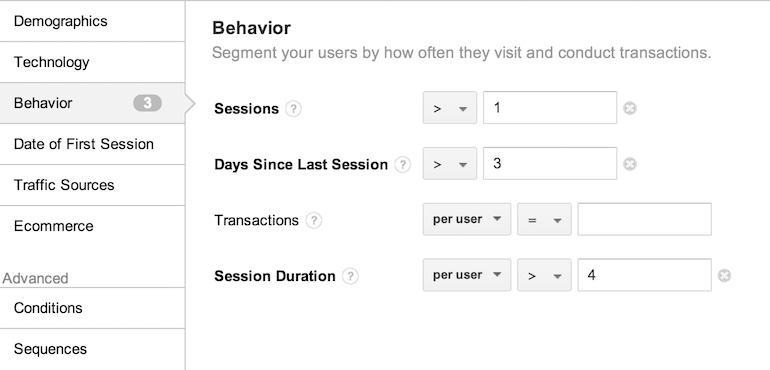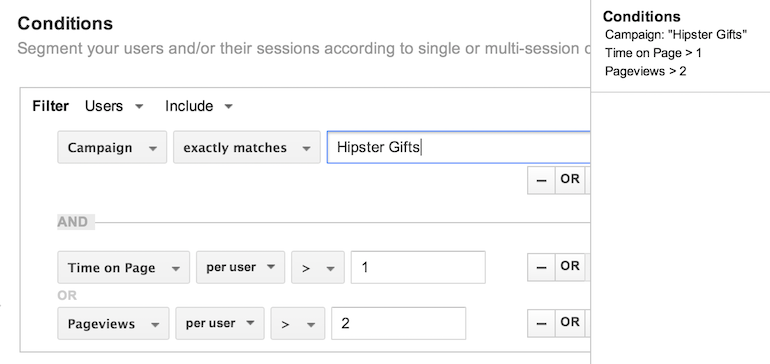
March 28, 2018
In PPC, the power of remarketing is undeniable. Being able to interact with those who’ve already experience your site is a huge advantage to those slow-pokes who haven’t figured it out quite yet.
But better than gloating about our clear expertise, let’s help those who are still struggling to get it together by breaking down where to start: Your remarketing lists. There are two common avenues for constructing remarketing lists: AdWords and Google Analytics. So what’s the difference between them?
From these lists, we’ll break down how you can benefit from each approach. When you’ve decided what works for you, we have many resources for the implementation & tag adjustment process.
Google AdWords
Search & Display Lists
Your remarketing lists built in AdWords are able to target audiences on both the Search and Display networks. Traditional remarketing and RLSA are both awaiting you, as is the use of remarketing lists in any Search + Display campaigns.
Goal Accomplished
Typically goals refer to conversions. Creating a list based off those who’ve either made a purchase (visitors you would commonly encourage to return for additional shopping) or those who’ve filled out a lead or sign-up form (visitors you would commonly exclude, as multiple leads from the same party are often unnecessary).
Pages Visited
The first step in creating a remarketing list is determining those to target and those to exclude, using the AdWords layout of “visitors of a page…”
Your choices are:


These choices allow you to include those who’ve visited your site, exclude those who have already converted (lead gen), and build off those exhibiting optimal behavior. This behavior may be someone who has previously purchased a product. It may also be someone who has navigated to the contact form of your site but perhaps failed to complete the conversion process.
Automatic Lists
The beauty of working through Google is the Google benefit. In the form of remarketing lists, this benefit consists of a series of pre-set categories, such as All Visitors and All Converters, allowing you to jump right in once they’ve reached their required size.
Google Analytics
When it comes to Google Analytics, your choices are similar to those in Google Adwords, but with so many more areas for expansion.
Search & Display
In order to use your Analytics tag to create remarketing lists for search ads, you must enable data collection for Remarketing features in your property settings.
Smart Lists
Similar to Google AdWords “Similar Audience” lists, Smart Lists allow Analytics to create their own idea of who would be the target audience for your products or services. This feature allows you to market to visitors likely to convert, even if they’re not on a predetermined remarketing list.

Pages Visited
Just like AdWords, you can target audiences based on the pages they’ve visited, such as a Thank You page (converted users) or a Log-In page. A Log-In page may be for already-paying users or members that provide little-added value when it comes to generating new leads.
Targeting “users who visited a specific section of my site” allows you to send distinct messages and images to those who’ve visited certain content. If you have a list based off of visitors to the Hipster Gifts page of your site, you may want to choose to mention the recent arrival of a new USB enabled typewriter (this is seriously a thing, people) or your wide selection of whiskey glasses.
Detailed Targeting
**Prepare to be Dazzled**
My favorite advantage to using GA remarketing is the near-infinite catalog of list options. Here, you’re not limited to just the URLs that have been visited, you can expand into so much more.
When creating your “custom segment” remarketing list in GA, you’ll be directed to this beauty of a tab:


While the Demographics option is open in this image, there are clearly oodles of targeting choices for your list. Here is a breakdown of my favorites and how and why I may opt to use for my remarketing.
Behavior
With the choices of targeting the number of times someone has been to your site in a period of time, or how recently they’ve been to your site, the number of transactions they’ve participated in, or the length of their visit, what’s not to love!

Here I’ve chosen to target those who’ve been to my site more than once in my 120 day period, meaning, I want them to want to buy from me. If they’ve seen my site more than once, then I know they weren’t completely put off by the experience. I’ve also established a “3 days since” setting, which means it’s been more than three days since their last visit. Did they forget about me? Were they price shopping and got distracted by the whiskey glass options found at a competitor site. My final setting for this list requires these visitors to have spent over 4 minutes on my site. This gives them time to look at products, look at product details, and perhaps even begin to assess the shipping fees and so on that accompany online orders. Because I know that for my client, the average order occurs in the 7th minute of site engagement, I want to collect a remarketing list based on folks who are exhibiting behavior similar to those who ultimately do make a purchase.
Note: Clearly, hyper-segmentation begets two things: very targeted messaging and relatively small lists. Be sure not to over-segment before you verify that the volume is there.
Technology
In this setting, you can hone in on the performance that seems to work best. If you see strong performance in your tablet-using audience, you have the opportunity to target them with remarketing. You can break out the OS, the browser, the version, and even the branding.

E-commerce
The settings for ecomm lists expand beyond just the product pages that were visited, or the stages of checkout a visitor completed. Putting those lists to shame are the options for specific product purchases, revenue thresholds, and recency of purchase. Visitors making large purchases may be interested in a set of products quite distinct from those buying under a particular price threshold. The ability to target them distinctly and use examples and language specific to that list is one of the best parts about Google Analytics Remarketing.

Traffic Source
Remarketing is such a particular channel for reaching those who’ve been to your site. What about those who found you through a certain avenue? In this list, I’m targeting those who found my site through not just Bing, but Bing PPC. I want to know who is likely to click on a compelling ad versus the organic listing or visiting via a direct search.

Conditions (Build Your Own)
What I love about working with Google’s tools is their ability to understand our need for control. While we’ve been provided with the aforementioned targeting options, we’re also given “carte blanche” to create any other type of list we might need.
I mentioned the interest in targeting those who’ve spent a certain amount of time on your site, or perhaps viewed a certain quantity of products. I’ve also lovingly poked fun at the way one might target a person looking for Hipster Gifts. Well, if I want to really hone in on those who responded to my Hipster Gift ad copy and have demonstrated desired behavior, conditional lists are the way to go.

All this talk of possible lists probably has your head spinning just a bit, which is why we’re going to bring it back to Earth and examine what’s actually happened in the real world.
The example below focuses on users who operate with a device set to a higher resolution as well as set to use Internet Explorer.

Why would I do this, you ask? Well, the product we’re marketing is often purchased by an older demographic. Although we know we can target by demographic, Google often incorrectly attributes age groups simply based on a user’s behavior.
Instead of accidentally targeting the wrong person based on some assumptions, creating a list based on settings that imply a certain stage of life and certain browser tendencies gives us more to work with.
When this list was put into real-life practice, we saw the following:

While the targeted group only made up 0.01% of the overall impressions and 0.02% of the total clicks, it had a conversion rate that was 56% higher than the campaign average. The fact that we highly qualified our targeting with the remarketing list and the subsequent messaging helped connect our ads with the appropriate users.
While I can’t promise a 56% conversion rate improvement, I can certainly identify the value of such customization. There are clearly many benefits to using Adwords Remarketing, Analytics Remarketing, or both. How about the rest of you? Have you used Analytics Remarketing? What custom targets have you used?
———-
Post originally published in August 2014 and updated by Alaina Thompson.